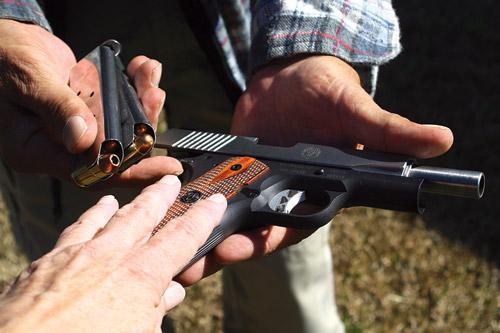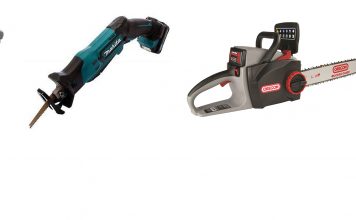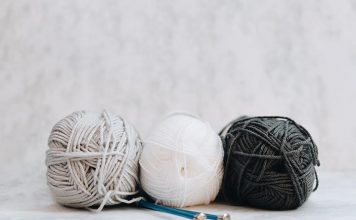 |
|
| Issue #153 • May/June, 2015 |
Note to readers: I’ve served for going on twenty years as firearms editor of Backwoods Home Magazine. The following article is going to be somewhat different from what you’re accustomed to seeing under my byline. I’m going to ask your indulgence, to read along and bear with me. If you are a reader disinterested in firearms who usually skips this column … well, I’m going to beg the same indulgence and ask you to read along for a bit, too. You see, it’s going to take some time to build the foundation on which this particular article is built.
Homesteader, farmer, rancher … each of those nouns calls to mind a self-reliant individual. When the United States was primarily a rural nation, there were more home births than hospital births. At the other end of the spectrum, end of life tended also to be in one’s own bed instead of the hospital, the body washed and dressed for the last time by family members instead of undertakers, and the final resting place being a home-hewn pine box in a grave on the family’s own property instead of the town cemetery.
Why is this publication’s Firearms Editor writing about suicide, and why does the topic appear at all in a publication titled Backwoods Home? Because, to face the truth, there is a nexus there.
Self-sufficient people tend to be so in all ways, from birth to death. If you are happy living in a sparsely populated place, everyone reading this publication will understand why. But they will also understand that sparse population puts us farther away from support systems. Emergency services take longer to respond, simply because they’re farther away and distance means time. The response of the fire department will take longer, which is why fire prevention and first-responder firefighting apparatus are more important to the rural citizen than his or her urban counterpart. It will take longer for paramedics and emergency medical technicians to get to an accident or heart attack scene in the boondocks, which is why first aid knowledge and equipment are proportionally more important there. And of course, it will take longer for police to arrive once they’ve been summoned to deal with violent criminals, which is one reason why every survey of gun ownership indicates more rural than urban households have firearms.
Now, combine that “we are prepared and equipped to take care of ourselves” attitude with a person who has decided life is no longer worth living. There is such a thing as “rational suicide,” seen classically among the terminally ill. But there is also the tragic “permanent solution to a temporary problem” phenomenon that anyone this side of a sociopath wants to keep from happening, and that is now the topic under discussion.
Is suicide proportionally more prevalent in rural America as opposed to urban/suburban?
A simple analysis
In the chart below, we see approximately 70% more suicides in the most rural settings than in the most densely urban. We also see that while non-firearms methods of self-inflicted death remained pretty consistent across the board, suicide by firearm was more than twice as high in the hinterlands than in the cities.

What could account for the differences? Setting agendas aside, this writer would point out four factors in particular.
“Less fear of death” factor. On the farm, where animals are routinely slaughtered and game regularly harvested for the table, birth and death lose their sense of awe and become simple facts of life. When you look at occupational categories of those who end their own lives, we consistently see medical professionals, law enforcement officers, and combat-experienced military personnel near the top of the list. One thing all those occupations have in common, of course, is constant exposure to human suffering that is unrelieved or at least inadequately relieved … but another is that they have seen enough human death that it has become common coin. To the average person, death is a horror that their culture has made it hard to even think about … but for those regularly exposed to death, it becomes simply one more problem-solving option when problems seem to have blotted out everything else in their lives.
“Self-determination” factor. Pride in the statement “I can take care of myself” is at the very core of self-reliance. The most memorable line of William Ernest Henley’s Victorian poem “Invictus” “I am the master of my fate/I am the captain of my soul” has been taught in public schools and posted on the walls of military barracks since before any of us were born. While those of us who strive to prevent suicide need to remind those with self-destructive ideation that these lines were also quoted by terrorist child-killer Timothy McVeigh, and remind the people we’re trying to save that they owe something to the good people who need them to be alive, we can’t escape the fact that this mindset helps drive some people to unnecessary self-inflicted death. We can’t prevent something we don’t understand. Self-sufficient people may, all other things being equal, be more inclined to suicide in certain situations.
“Isolation” factor. When you are “far from the madding [sic] crowd” isolation can be good; when you need help from others, obviously, it’s bad. The rural person, particularly when living alone, has less access to human support when depression and grief become overwhelming.
“Availability of means” factor. The suicidal MD or nurse tends to end their life with a pharmaceutical overdose. The suicidal police officer or soldier tends to “eat his gun.” A part of this, some believe, is a conscious or subconscious way of using a symbol of their occupation as their exit means to make the statement, “Look what my job did to me!” However, we cannot escape another logical possibility: When these people made the decision to end their lives, they took recourse to something their life experience taught them was likely to perform the task. Something they were familiar with. And, yes, something that was readily available to them.

Before lending a gun to a non-gun owner, check for signs of suicidal ideation. Conversely, securing a troubled friend’s guns for a while may prevent tragedy.
One element of prevention
Depriving the person with a seemingly-overwhelming “temporary problem” from their “permanent solution” can be, at the very least, a temporary saving of life. With that in mind, I introduce you to a group I joined many years ago, the New Hampshire Firearms Safety Coalition (NHFSC).
Founded and still chaired by Elaine Frank of the Injury Prevention Center at Dartmouth Hitchcock Medical Center in Lebanon, New Hampshire, the NHFSC is something unique. It is, to my knowledge, the first organization to effectively bring the two warring factions of the “gun control” issue to the same table, working together in common cause for the public good. In a time when the gun issue has been said to rival abortion as the most polarized debate in American society, Elaine accomplished the seemingly impossible task of getting senior members of both Gun Owners of New Hampshire and CeaseFire New Hampshire to set aside debate on this contentious issue and, at the same table with health care professionals who were neutral on the gun issue, focus solely on preventing unnecessary deaths and injuries.
What came out of that in the years since were firearms safety training films, distribution of free gun locks at county fairs and similar gatherings … and a model suicide prevention program. The catalyst of the latter was a staunch Second Amendment advocate, Ralph Demicco, then owner of the largest and most famous gun shop in the state, Riley’s in Hooksett, New Hampshire.
Here’s how NHFSC explains it, at http://www.theconnectprogram.org/firearms-safety-coalitions-role-nh-suicide-prevention: “In 2009, in the course of less than a week, three people (with no connection to each other) bought a firearm from the same store and killed themselves within hours of the purchase. The Medical Examiner’s office brought this to the attention of their mental health liaison, and a small group of firearm retailers and mental health/public health practitioners met to explore whether there might be a role for gun stores in preventing suicide. The group was later adopted by the NH Firearm Safety Coalition.
According to information abstracted from the NH Medical Examiner’s death investigation reports, among the 144 firearm suicides that occurred over a two-year period ending 6/30/09, nearly one in ten were committed with a gun that was purchased or rented within a week of the suicide (usually within hours). The figure is likely an underestimate since two-thirds of the reports made no mention of when the gun was obtained.”
That gun dealer was Ralph Demicco. The result is NHFSC’s Gun Shop Suicide Prevention Program, which has now been adopted by roughly half of the firearms emporiums in the Granite State and has been adapted in other areas of the country. It encompasses suicide prevention handout materials conspicuously displayed on the counter, related posters on the walls, and staff trained to recognize signals of suicidal ideation (thoughts) in customers.
And here is where you come in …
Some people who decide, however impulsively, to shoot themselves to death have guns immediately at hand already. What we’re about to look at here won’t change that. Instead, we are addressing the people who have made a plan to end their life and, having determined that shooting themselves may be the swiftest and surest means to that end, are now reaching out for a gun they don’t presently possess, with which to carry out that act.
Some, as NHFSC has noted, go to a gun shop and buy the firearm. There have also been cases of people going to ranges that rent guns, and killing themselves on the range, an act which horribly traumatizes everyone else present as well as the survivors of the deceased.
And please pay attention, because I’m finally reaching a key point here there are those who will borrow a gun from a friend or neighbor with which to end their lives.
If you are that friend or that neighbor, you stand in the same position as the gun dealer when that unknown-to-be-suicidal person comes to you to acquire a firearm … and you need to know what the NHFSC and those educated gun-sellers now know.

NHFSC members who worked on the Gun Shop Project included (front row) Elaine Frank and Elizabeth Fenner-Lukaitis, (back row) Ralph Demicco, Elaine deMello, Howard Brown, Sarah Brown, Mary Vriniotis, and David Welch. Absent: Cathy Barber, Tom Brown and John Yule. Photo courtesy NHFSC.
Things to look for
Don’t expect the warning signal to be as obvious as “Hey, I need a gun … and one cartridge.” When someone known to you as a non-gun owner asks to borrow a gun, quiz them as to why. Don’t make it an accusing “Whaddaya want a deadly weapon for?” Instead, say something like, “Well, guns are tools. If you asked to borrow one of my tools, I’d ask you if you’re going to cut boards or pound nails, because that would help me to decide whether to lend you a saw or a hammer. Different guns are for shooting different things. What do you need to shoot?” And take it from there.
An answer like, “I just need a gun!” is a red flag. More questioning and analysis of answers is indicated. In the NHFSC program, gun dealers are taught to ask, “Do you have a cleaning kit?” A “yes” answer is fairly copacetic. The cryptic “I won’t be needing that” may be another red flag.
If a neighbor asked to borrow a chainsaw or your backhoe or something in between, one of your first questions would be, “How experienced are you with that equipment?” If the answer was anything from “It doesn’t matter” to “None of your business,” I doubt you’d be lending them that gear. The same must be true with a firearm! If the person requesting is someone you know or suspect has little or no knowledge of firearms operation and safety, invite them to a firearms safety session. If the answer is anything like “I don’t need it” or “I don’t have time for that,” another red warning flag is flying.
You, the friend/relative/neighbor, have an advantage the person behind the gun shop counter does not: You know this person. Apply that knowledge to their request for a gun.
Have they been depressed lately? Gravely ill? Suffered the loss of a loved one, or a crushing economic reverse? Have they been recently dumped by a lover or spouse? I put the latter in italics for two reasons: It seems to be a particular trigger for the departure-from-life impulse, and it’s associated with not just intent to commit suicide, but sometimes, intent to commit murder as well. All of these can be red flags.
When someone you know asks to borrow a lethal weapon, and it seems out of character for them to do so, be particularly alert for signs of “departure ritual.” The person who has committed herself to leaving life behind will often put her affairs in order. The person who has been chronically tardy in paying bills suddenly brings all accounts up to date, for example. Conversely, in one case I worked, the individual burned all his bills in a ritual bonfire the night before he committed “suicide by cop,” attacking police with a weapon and forcing a sergeant to shoot him to death.
Be looking for the person who suddenly resigned from every committee she belonged to, or the one who suddenly, for no apparent good reason, gave up a job he loved. Another warning signal is the fastidious person who suddenly goes unwashed and scruffily dressed. Yet another is the person who has been “down” to a worrisome degree, who suddenly is bright and cheerful; it may signal “the eye of the storm,” the once-troubled person now happy and calm because he sees himself as about to leave all his troubles behind.
Has the individual recently been looking up old friends and acquaintances? Any of us can find ourselves doing that in our later years, but sometimes it can be a signal of suicidal ideation. At the funeral, those friends will say, “I realize now that he was saying goodbye.”
The most starkly red of all flags, in my experience, is the giving away of long-cherished possessions. When your friend gives you the Mustang he’s carefully maintained since his school days, or some favorite possession of his that you’ve long admired, or his beloved pet, he is very likely saying “I have made a commitment to depart from life, and I want this thing I cherished to be taken care of by someone who will love and appreciate it as I did.” When you start seeing that, particularly in company with other “suicide signals,” my advice is to run, not walk, to the nearest suicide prevention hotline.
The sort of training found in NH Firearms Safety Coalition’s Gun Shop Program has already saved lives. From the NHFSC’s files: “A woman came into the shop asking about buying a gun because of some emotional problems. I told her she didn’t need a gun, she needed spiritual help. So I took her to my pastor. She never did come back for a gun.” And, “There was a guy I wouldn’t sell a gun to because he just didn’t seem right. I later got a letter from his attorney thanking me for saving his client’s life.”

Suicide prevention poster created by the New Hampshire Firearms Safety Coalition. Image courtesy NHFSC.
Holding their guns
One “friends helping friends” thrust of the NHFSC’s suicide prevention efforts is the suggestion that the helper offer to take the troubled person’s firearms and secure them until things are better. While this can certainly prevent some tragedies, it also presents risks. Some individuals may see this as an attempt to disempower them. If they are contemplating suicide in the first place because they feel weak and disenfranchised, it may compromise their trust in the helper, not only forestalling the suicide intervention effort but perhaps even generating hostility toward the helper. There are also legal concerns: For example, under the recently passed Initiative 594 in Washington State, the helper would be guilty of a gross misdemeanor (first offense) or even a felony (second offense) if they took possession of the firearms without an official transfer of possession through a Federal Firearms License holder. Many troubled people would balk at losing possession of their firearms in this manner, an unintended consequence of that legislation which impedes this sort of life-saving effort.
What you can do
It is a tradition in rural communities to join in volunteer public service: becoming a volunteer firefighter, or an Emergency Medical Technician on the volunteer ambulance service, or even a reserve police officer. Even for those no longer able-bodied, another option is joining a crisis hotline or suicide prevention hotline group. The price you’ll pay will be donating some of your time to be available at the other end of the phone when someone in trouble calls in. The reward you’ll reap is that, while you probably won’t be paid, you’ll be given at no cost to yourself state-of-the-art training in verbal crisis intervention. In the time of cell phones, when you’re “on watch” you aren’t even tethered to the home telephone anymore. Go to the community service pages in the front of your local telephone book, where you’ll find those organizations listed. They’re usually desperate for committed volunteers.
All of us in public safety and emergency services work learn early that we can’t save them all. But we can damn sure save some.
Let me thank Elaine Frank, Ralph Demicco, and the many other committed members of the New Hampshire Firearms Safety Coalition for the good, life-saving work they have done. I hope their message spreads.














